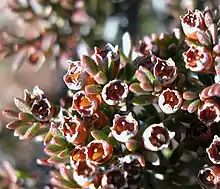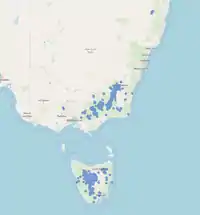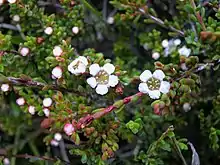Baeckea gunniana
Baeckea gunniana, commonly known as alpine baeckea, is a species of a compact, densely branched evergreen shrub, growing in alpine and sub-alpine Australia.[1] Baeckea is a genus of flowering plants in the myrtle family, Myrtaceae, comprising 14 species occurring in eastern Australia and Asia.[2]
| Baeckea gunniana | |
|---|---|
 | |
| Baeckea gunniana Photo © Greg Jordan. © 2019 University of Tasmania | |
| Scientific classification | |
| Kingdom: | Plantae |
| Clade: | Tracheophytes |
| Clade: | Angiosperms |
| Clade: | Eudicots |
| Clade: | Rosids |
| Order: | Myrtales |
| Family: | Myrtaceae |
| Genus: | Baeckea |
| Species: | B. gunniana |
| Binomial name | |
| Baeckea gunniana Schauer ex Walp. | |
 | |
| Occurrence distribution of Baeckea gunniana Atlas of Living Australia, Map data © OpenStreetMap, imagery © CartoDB | |
Description
Baeckea gunniana is a smooth, compact shrub growing to 1.5 m high, although can reach up to 2 m at lower altitudes.[3] It is sometimes prostrate or spreading over rocks and boulders.[4] Branchlets are brown with a flat segment on a papery or fibrous brown bark.[2] Leaves are small (2–4 mm long; 0.6-0.8 mm wide) and crowded, obovate to oblong shaped with a blunt apex,[3] and with entire margins and petioles c. 0.5 mm long.[2] The flowers are white, small and numerous, borne solitarily in the upper leaf axils.[5] Sepals are triangular and obtuse, with a corolla 4–5 mm in diameter and circular petals c. 1–1.8 mm long. Stamens 4–6, not opposite petals. The ovary has a single locule. Style is terete and only slightly inserted into the ovary summit.[3] The unilocular ovary, where the pendulous placenta and ovules are enclosed by a single membrane, is characteristic to the species and unique in the genus.[2]
The fruit is green and cup-like when immature[5] and woody, dehiscent capsule at maturity.[3] Seeds are small and angular, remaining inconspicuous on the ground upon release.[3][5] Seed coat/covering or testa of some Baeckea species has been recorded to form a physical barrier inhibiting seed germination.[3] This may be reverted by removing or nicking the testa using a needle or scalpel, improving the rate of germination.[3] B. gunniana can also be vegetatively propagated from cuttings of semi-hardened new growth.
Distribution and habitat
Distribution is restricted to alpine or subalpine regions, from Mt Ginini in ACT to south-west Tasmania.[3][2] Baeckea gunniana is most prevalent at high altitudes between 1000 to 1400 m. However, it has been observed to grow above 2000 m near Mt Kosciusko, and as low as 450 m in western Tasmania.[2] All species in the genus Baeckea are confined to Australia, except for the type species, B. frutescens (L.), which extends from eastern Australia through Malesia to China.[2]
Baeckea gunniana is commonly found growing with species such as Callistemon pityoides, Epacris paludosa, and Empodisma minus, in heathlands or boggy sedgeland.[2] It is also common near creeks, and sometimes in shaded areas under Eucalyptus spp.[3]
Taxonomy and phylogeny
The species was first formally described by the German botanist Johannes Conrad Schauer in 1843.[6]
The closest Myrtaceae sensu stricto lineage is represented by two fleshy fruited (Myrcianthes and Acmena) and three dry fruited taxa. Angophora and Backhousia are sister genera to Baeckea, belonging to a dry-fruited lineage of Myrtaceae.[7]
Uses and cultivation
Baeckea leaves are edible and often used as a tea substitute because of their aromatic citrus-like flavour.[1][8] Extracts from B. gunniana have been found to inhibit the activity of DNA Polymerase enzyme.[9] It forms an integral part of the Broad-toothed mouse habitat in NSW, Australia, providing protection from predators and other large grazers.[8]

References
- "Key to Tasmanian Dicots". University of Tasmania. Retrieved 28 November 2019.
- Bean, Anthony (1997). "A revision of Baeckea (Myrtaceae) in eastern Australia, Malesia and south-east Asia". Telopea. 7 (3): 245–268. doi:10.7751/telopea19971018. ISSN 0312-9764.
- "Baeckea gunniana - Growing Native Plants". Australian National Botanic Gardens. Retrieved 28 November 2019.
- Walsh, N. Entwisle, Timothy J. (1996). Flora of Victoria. Volume 3, dicotyledons Winteraceae to Myrtaceae. Inkata. ISBN 0-409-30852-8. OCLC 223634887.CS1 maint: multiple names: authors list (link)
- "Flora of Victoria". vicflora.rbg.vic.gov.au. Retrieved 4 December 2019.
- Australia, Atlas of Living. "Baeckea gunniana". bie.ala.org.au. Retrieved 4 December 2019.
- Conti, Elena; Litt, Amy; Wilson, Peter G.; Graham, Shirley A.; Briggs, Barbara G.; Johnson, L. A. S.; Sytsma, Kenneth J. (1997). "Interfamilial Relationships in Myrtales: Molecular Phylogeny and Patterns of Morphological Evolution". Systematic Botany. 22 (4): 629. doi:10.2307/2419432. ISSN 0363-6445. JSTOR 2419432.
- Belcher, C.; Leslie, D. (2011). "Broad-toothed RatMastacomys fuscusdistribution in Buccleuch, Bago and Maragle State Forests, NSW". Australian Zoologist. 35 (3): 555–559. doi:10.7882/az.2011.007. ISSN 0067-2238.
- Deng, Jing-Zhen; Starck, Shelley R.; Hecht, Sidney M. (2019). "DNA Polymerase β Inhibitors fromBaeckea gunniana". Journal of Natural Products. 62 (12): 1624–1626. doi:10.1021/np990240w. ISSN 0163-3864. PMID 10654412.

